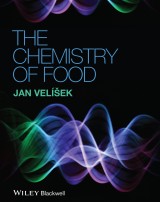Details

The Chemistry of Food
1. Aufl.
|
68,99 € |
|
| Verlag: | Wiley-Blackwell |
| Format: | |
| Veröffentl.: | 24.12.2013 |
| ISBN/EAN: | 9781118383834 |
| Sprache: | englisch |
| Anzahl Seiten: | 1136 |
DRM-geschütztes eBook, Sie benötigen z.B. Adobe Digital Editions und eine Adobe ID zum Lesen.
Beschreibungen
THE CHEMISTRY OF FOOD <p>THE CHEMISTRY OF FOOD <p>This advanced textbook covers all the main macro- and micronutrients and the essential nutritional factors that determine the nutritional and energy value of foods and raw food material. It includes chapters devoted to amino acids, peptides and proteins, fats and other lipids, carbohydrates, vitamins, mineral substances and water, and in addition to chapters devoted to antinutritional, toxic and other biologically active substances, food additives and contaminants. <p>Each chapter addresses one of the main individual components of food, reviewing its important properties and functions. Detailed descriptions and explanations of the changes and chemical/biochemical reactions that occur under different conditions are also covered. The book provides a comprehensive overview of the chemical composition of foods and the changes that take place during food production, processing and storage. With an extensive list of tables and its comprehensive coverage, this almost encyclopaedic volume will be ideal for students at the Masters level and beyond, and is a vital all-in-one reference for professional food chemists, researchers and the food industry. <p><i>The Chemistry of Food </i>is supported by a website of online resources, including web links to relevant news and journal articles, references and further reading, glossary of key terms, and revision notes for all topics/chapters.
PREFACE vii <p>ABOUT THE COMPANION WEBSITE ix</p> <p><b>CHAPTER 1 INTRODUCTION 1</b></p> <p><b>CHAPTER 2 AMINO ACIDS, PEPTIDES AND PROTEINS 4</b></p> <p>2.1 Introduction 4</p> <p>2.2 Amino acids 4</p> <p>2.3 Peptides 27</p> <p>2.4 Proteins 35</p> <p>2.5 Reactions 63</p> <p><b>CHAPTER 3 FATS, OILS AND OTHER LIPIDS 87</b></p> <p>3.1 Introduction 87</p> <p>3.2 Classification 87</p> <p>3.3 Fatty acids 88</p> <p>3.4 Homolipids 108</p> <p>3.5 Heterolipids 123</p> <p>3.6 Miscellaneous simple and complex lipids 129</p> <p>3.7 Substances accompanying lipids 132</p> <p>3.8 Reactions 145</p> <p><b>CHAPTER 4 SACCHARIDES 198</b></p> <p>4.1 Introduction 198</p> <p>4.2 Monosaccharides 199</p> <p>4.3 Derivatives of monosaccharides 207</p> <p>4.4 Oligosaccharides 217</p> <p>4.5 Polysaccharides 230</p> <p>4.6 Complex saccharides 278</p> <p>4.7 Reactions 280</p> <p><b>CHAPTER 5 VITAMINS 335</b></p> <p>5.1 Introduction 335</p> <p>5.2 Vitamin A 337</p> <p>5.3 Vitamin D 345</p> <p>5.4 Vitamin E 349</p> <p>5.5 Vitamin K 356</p> <p>5.6 Thiamine 359</p> <p>5.7 Riboflavin 364</p> <p>5.8 Niacin 367</p> <p>5.9 Pantothenic acid 370</p> <p>5.10 Pyridoxal, pyridoxol and pyridoxamine 372</p> <p>5.11 Biotin 375</p> <p>5.12 Folacin 377</p> <p>5.13 Corrinoids 380</p> <p>5.14 Vitamin C 384</p> <p>5.15 Other active substances 396</p> <p><b>CHAPTER 6 MINERALS 402</b></p> <p>6.1 Introduction 402</p> <p>6.2 Chemistry of minerals 404</p> <p>6.3 Essential elements 416</p> <p>6.4 Non-essential elements 442</p> <p>6.5 Toxic elements 444</p> <p>6.6 Toxic inorganic anions 451</p> <p>6.7 Radionuclides 454</p> <p><b>CHAPTER 7 WATER 459</b></p> <p>7.1 Introduction 459</p> <p>7.2 Drinking water 459</p> <p>7.3 Water in foods 463</p> <p>7.4 Structure 464</p> <p>7.5 Properties 466</p> <p>7.6 Interactions 466</p> <p>7.7 Phase interfaces 473</p> <p>7.8 Food dispersed systems 477</p> <p>7.9 Water activity 494</p> <p><b>CHAPTER 8 FLAVOUR-ACTIVE COMPOUNDS 499</b></p> <p>8.1 Introduction 499</p> <p>8.2 Odour-active substances 500</p> <p>8.3 Taste-active substances 621</p> <p><b>CHAPTER 9 PIGMENTS AND OTHER COLORANTS 656</b></p> <p>9.1 Introduction 656</p> <p>9.2 Tetrapyrroles 657</p> <p>9.3 Other nitrogen pigments 669</p> <p>9.4 Flavonoids 677</p> <p>9.5 Xanthones 699</p> <p>9.6 Curcuminoids 701</p> <p>9.7 Isochromenes 701</p> <p>9.8 Quinoid pigments 703</p> <p>9.9 Carotenoids 713</p> <p>9.10 Iridoids 730</p> <p>9.11 Other terpenoid pigments 730</p> <p>9.12 Enzymatic browning reactions 732</p> <p><b>CHAPTER 10 ANTINUTRITIONAL, TOXIC AND OTHER BIOACTIVE COMPOUNDS 741</b></p> <p>10.1 Introduction 741</p> <p>10.2 Antinutritional compounds 743</p> <p>10.3 Toxic compounds 747</p> <p><b>CHAPTER 11 FOOD ADDITIVES 847</b></p> <p>11.1 Introduction 847</p> <p>11.2 Substances prolonging the shelf life of foods 848</p> <p>11.3 Substances regulating odour and taste 863</p> <p>11.4 Substances modifying colour 875</p> <p>11.5 Substances modifying texture 882</p> <p>11.6 Substances increasing biological value 888</p> <p>11.7 Other food additives 888</p> <p><b>CHAPTER 12 FOOD CONTAMINANTS 892</b></p> <p>12.1 Introduction 892</p> <p>12.2 Technological contaminants 894</p> <p>12.3 Microbial toxins 942</p> <p>12.4 Persistent organohalogen contaminants 963</p> <p>12.5 Chlorinated aliphatic hydrocarbons 999</p> <p>12.6 Pesticides 999</p> <p>12.7 Veterinary drugs 1022</p> <p>12.8 Contaminants from packaging materials 1031</p> <p>BIBLIOGRAPHY 1041</p> <p>INDEX 1079</p>
<p>“This book, a translation from the Czech version, is an excellent, thorough resource, complete with 37 pages of primary references and a detailed, useful index. It will certainly be valuable for the many food chemistry courses that are increasingly being offered in chemistry departments. Summing Up: Highly recommended. Upper-division undergraduates and above.” (<i>Choice</i>, 1 January 2015)</p>
<p> THE AUTHOR <p><b>Jan Velíšek </b>is Professor of Food Chemistry and Analysis at the Institute of Chemical Technology (ICT), Prague, Czech republic <p>ALSO AVAILABLE FROM WILEY BLACKWELL <p><b>The Chemistry of Food Additives and Preservatives</b><BR> By Titus A. M. Msagati<BR> ISBN: 978-1-118-27414-9 <p><b>Food Carbohydrate Chemistry</b><BR> By Ronald E. Wrolstad<BR> ISBN: 978-0-8138-2665-3
<p>THE CHEMISTRY OF FOOD <p>This advanced textbook covers all the main macro- and micronutrients and the essential nutritional factors that determine the nutritional and energy value of foods and raw food material. It includes chapters devoted to amino acids, peptides and proteins, fats and other lipids, carbohydrates, vitamins, mineral substances and water, and in addition to chapters devoted to antinutritional, toxic and other biologically active substances, food additives and contaminants. <p>Each chapter addresses one of the main individual components of food, reviewing its important properties and functions. Detailed descriptions and explanations of the changes and chemical/biochemical reactions that occur under different conditions are also covered. The book provides a comprehensive overview of the chemical composition of foods and the changes that take place during food production, processing and storage. With an extensive list of tables and its comprehensive coverage, this almost encyclopaedic volume will be ideal for students at the Masters level and beyond, and is a vital all-in-one reference for professional food chemists, researchers and the food industry. <p><i>The Chemistry of Food </i>is supported by a website of online resources, including web links to relevant news and journal articles, references and further reading, glossary of key terms, and revision notes for all topics/chapters.


















